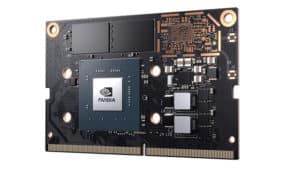Nvidia EGX Platform: The Future of AI & IoT Starts at $99
by Adrian Bowles
As a general principle, decision-making is more efficient and effective as you get closer to the source of data or evidence required to support the decision. The old way—with information flowing up a hierarchy to centralized command and control, and instructions flowing down to the field—is being replaced with a new way in enterprises. Organization charts are being flattened and individuals at lower levels are beginning to be empowered to take action based on events and evidence, and report their findings after the fact.

The new model works when the person “at the edge” has the data, and more importantly, the intelligence to interpret and act on that data autonomously but with the larger interests of the enterprise in mind. This blog examines NVIDIA‘s new EGX Platform and what it means for the future of edge AI.
The Logical Next-Step Is Making Edge Devices Smarter
In today’s technology world, the most powerful computing resources are generally available in the cloud, and the evidence-gathering components are edge devices, ranging from simple sensors to appliances, which may have some simple logic and autonomy (engage the ABS system when sensors detect that wheels are not rotating but car is still moving forward, indicating a skid). As more and more data is collected by these edge devices, the logical next step is to make them smarter and minimize the communication with central command (cloud) as much as possible. That is already done in areas like aerospace and military vehicles, where data may not be reliably transmitted during flight or fight, but most of these applications involve fairly sizable devices. That is changing, and the recent introduction of the EGX Platform by NVIDIA represents a significant step forward.
What Does NVIDIA’s EGX Platform Do?
NVIDIA calls EGX “an accelerated computing platform that enables companies to perform low-latency AI at the edge.” EGX represents a consistent architecture for data capture, machine learning, and communications that scales from the Jetson Nano ($99) to their high-end servers. The Nano is significant because it brings a high power architecture for machine learning to the edge in a small footprint, low power draw (5-10 watts) at a starting price of $99.
Jetson Nano Highlights:
- .5 trillion operations/second (TOPS) with a footprint about the size of a business card (70/70x45mm)
- NVIDIA Maxwell architecture with 128 NVIDIA CUDA Cores
- H.264/265 video decode
Key EGX Takeaways for Buyers:
- Edge devices can communicate directly via 5G
- EGX servers are available from NVIDIA partners including Atos, Cisco, Dell EMC, and HPE
- NVIDIA partnered with Red Hat to integrate their Edge Stack with Open Shift
Bottom Line
We predict a rapid adoption of this type of architecture (Edge AI, Gateway, server in the cloud) over the course of the next decade. Distributing intelligence and autonomy to the edge of the network is as important as distributing autonomy to the field in an organization. The limiting factor in the past has been the ability of the edge devices to make evidence-based decisions in real time based on streaming data, due to their computational power limitations. That’s what has been addressed with the Jetson Nano. Sure, in a decade every edge device may have an AI-processor that is smaller, faster, and cheaper than the Nano. For enterprises that want to leverage the power of real-time decision making at the edge using machine learning today, however, evaluating the EGX Platform should be considered an imperative.


Have a Comment on this?